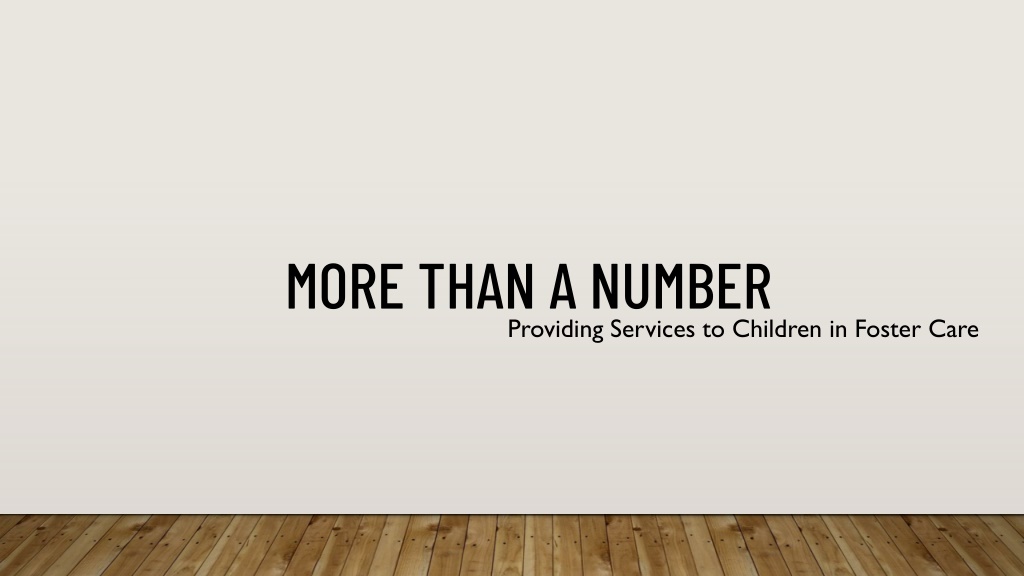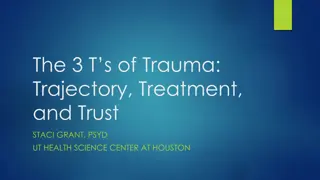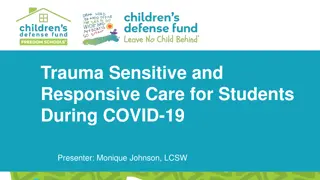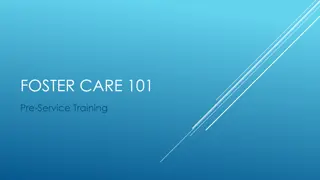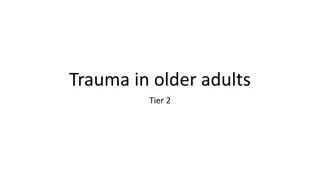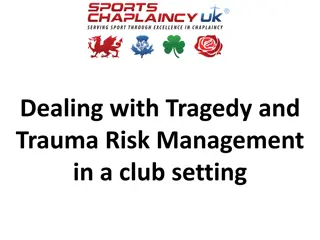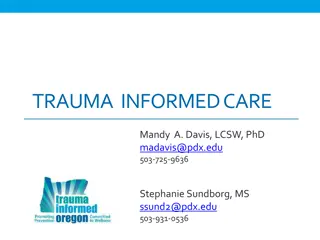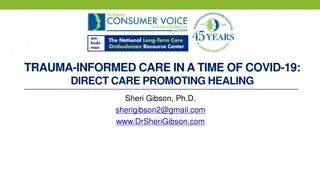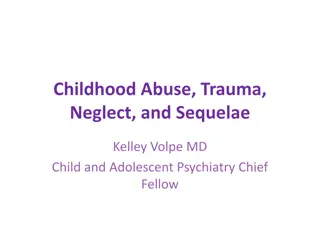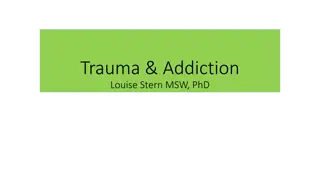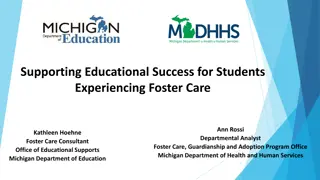Understanding Trauma and Foster Care: A Comprehensive Insight
Explore the complex dynamics of trauma experienced by children in foster care, including the various forms of abuse and neglect they may face. Learn how trauma manifests in children and the potential effects on their behavior. Gain valuable insights into strengthening partnerships with service providers and implementing best practices when working with foster youth.
Download Presentation

Please find below an Image/Link to download the presentation.
The content on the website is provided AS IS for your information and personal use only. It may not be sold, licensed, or shared on other websites without obtaining consent from the author. Download presentation by click this link. If you encounter any issues during the download, it is possible that the publisher has removed the file from their server.
E N D
Presentation Transcript
MORE THAN A NUMBER Providing Services to Children in Foster Care
Introductions BRITTANY JOHNSON CASSIE STOCKTON Department for Community Based Services Recruitment and Certification Bachelors of Social Worker Department for Community Based Services Recruitment and Certification Bachelors of Social Worker
FOSTER CARE IMAGINED
OBJECTIVES Individuals will understand the dynamics of foster care and trauma and how effects and behaviors will differ each child in foster care. What is Trauma? Child Reactions to Trauma Introduction to Cycle of Need Discover Potential ways to Strengthen partnership with DCBS Learn Best Practice skills for working with children and youth in foster care. Individuals will listen to firsthand experience from a former foster youth and adoptee. During this time the presenters will provide insight into what made relationships and rapport with some of their services providers and families successful.
DEFINING TRAUMA Trauma results from an event, series of events, or set of circumstances Acute Single Event That is experienced by an individual as physically or emotionally harmful or threatening Complex Has lasting adverse effects on the individual's functioning and physical, social, emotional, or spiritual well-being. Multiple occurrences over a period One event maybe traumatic for one and not for another
WHAT DOES THIS LOOK LIKE FOR FOSTER CHILDREN IN CARE? Physical Abuse Neglect Risk of Harm Exposure to Substance abuse Exposure to Domestic Violence Sexual Abuse Emotional Abuse Human Trafficking Dependency
HOW MIGHT THEY REACT TO THIS TRAUMA? Decreased concentration Difficulty sleeping Lack of motivation or interest in activities Easily startled/hyper arousal Socially withdrawal Avoidance of past traumatic activities and places Adverse Behaviors/Repetitive Behaviors
AN INDIVIDUALS BODY ALSO REACTS POSSIBLY AFFECTING: Cognitive development Physical Response to Trauma Health Blood Pressure Bone Density Sugar Levels Immune System Etc.
EVERY CHILD EVERY CHILD WHO HAS ENTERED FOSTER CARE HAS EXPERIENCED TRAUMA.
WHAT DOES FOSTER CARE LOOK LIKE IN KENTUCKY? Let s Look at the Kentucky Foster Care Statistics: As of August 2023, there were approximately 8,352children in foster care within the state of Kentucky. Approximately 6,205 were early head start age and above. (3 years or older) Average age to foster care entry = 7 Years Old Only around 50% of those 8,352 children have the goal of reunification with their birth parents.
DID YOU KNOW? According to the ACE s Study Children who experience the following are at higher risk for adverse challenges as adults : Childhood abuse (Emotional, Physical, or Sexual) Neglect (Emotional or Physical) Household Dysfunction Domestic Violence Mental Illness Substance Abuse Parental Divorce/Separation Crime/Incarceration
ACE RISKS INCLUDE Alcoholism Smoking Illicit Drug Abuse Obesity Suicide Attempts Depression/Anxiety Teen and Unintended Pregnancies Intimate Partner Violence Poor Quality of Life COPD Heart Disease Liver Disease STD Lung Cancer Death before 65
HOW CAN I HELP FACILITATE CHANGE?
STRENGTHENING COLLABORATION
WHAT ARE SOME WAYS TO STRENGTHEN OUR COLLABORATION? Understand the Child Welfare System Develop clear and consistent guidelines to facilitate information sharing across systems Provide cross-training for all involved individuals and organizations
UNDERSTANDING THE CHILD WELFARE SYSTEM
Biological Family Other Agencies (Mental health, etc) Licensed Foster Home CHILD Court System DCBS Guardian Ad Litem or CASA Volunteer School
HOW DOES A CHILD ENTER FOSTER CARE & WHAT HAPPENS ONCE THEY HAVE? Continued court reviews and hearings until permanency is achieved Removal Temporary Removal Hearing within 72 hours Report of Abuse of Neglect Finding of Abuse Adjudication Hearing Investigation Disposition
DEVELOP GUIDELINES FOR INFORMATION SHARING
PROVIDE CROSS- TRAINING
HOW CAN I BEST SERVE CHILDREN WHO HAVE EXPERIENCED TRAUMA?
LOOKING BEYOND BEHAVIORS
USE YOUR TRAUMA LENS A trauma-focused lens allows workers and caregivers to understand behaviors and provide important healing Looking past these behaviors and towards their needs can be detrimental in helping them build new skills and behaviors. Simply stopping a behavior can be ineffective for a child who has experienced trauma.
WHY? Need (Underlying Condition) Need is Satisfied/Not Satisfied Cycle of Need Our Reaction Behavior
UNDERSTAND THAT FOSTER CARE IS MULTICULTURAL
AVOID A BLANKETED APPROACH
